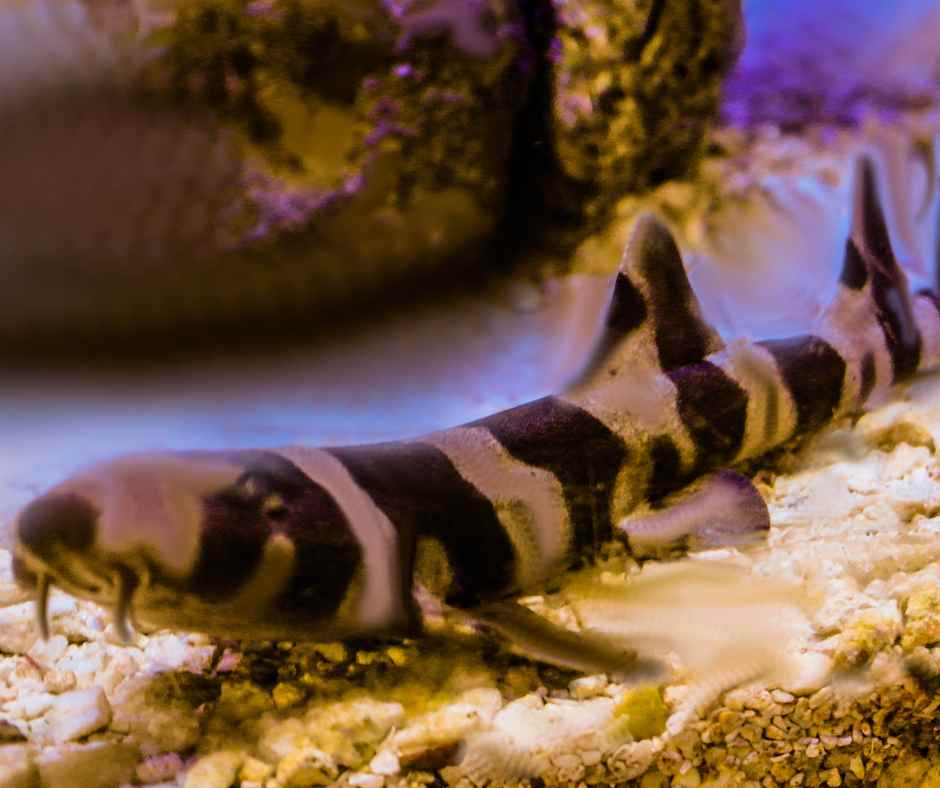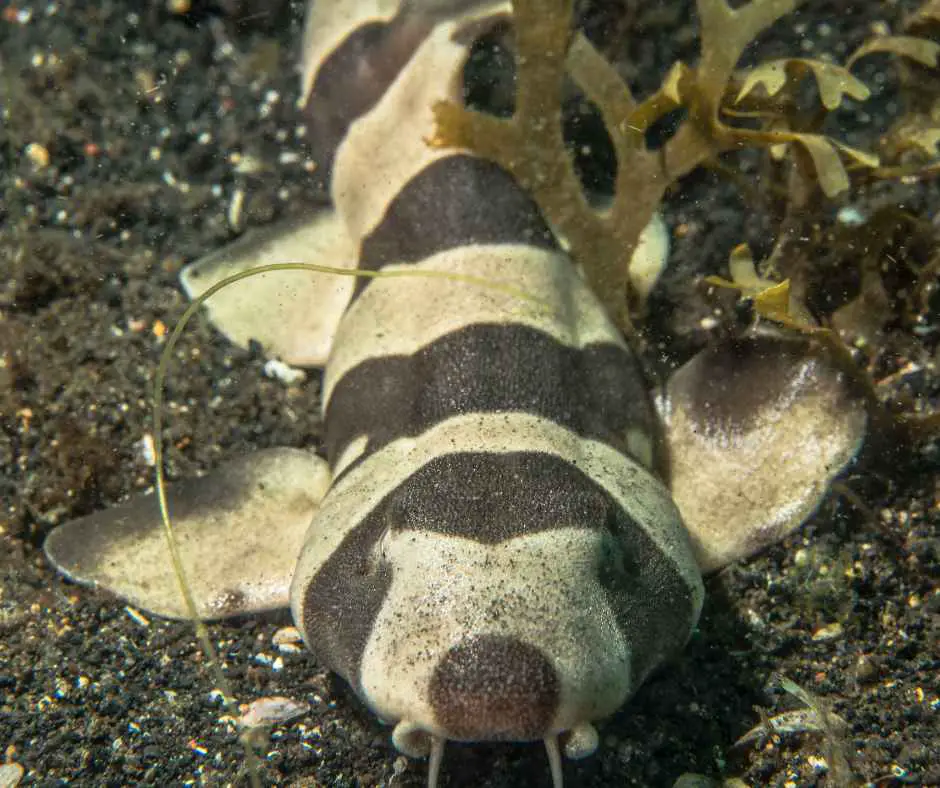The white spotted bamboo shark (Chiloscyllium plagiosum) is a species of carpet shark. It is called the “bamboo shark” due to its habit of resting in tight crevices, reminiscent of bamboo shoots. These sharks are harmless, nocturnal, and small in size.

However, that’s not all! There are more interesting facts regarding this shark species. Hence, we will discuss them in detail in today’s blog.
White Spotted Bamboo Shark Facts
White-spotted bamboo sharks, also called bamboo catsharks, are enthralling creatures! They have a distinctive appearance, unique biology, and peaceful behavior. Thus, they have captured the attention of many aquarium enthusiasts and marine biologists alike. Further, some significant white-spotted bamboo shark facts are as follows;
White Spotted Bamboo Shark Size
White-spotted bamboo sharks grow to a moderate size. They reach a maximum length of around 3.5 feet in the case of females and 2.5 feet in the case of males. They have slender, cylindrical bodies. Bamboo sharks are relatively slow-growing. Thus, it takes them several years to reach their maximum size.
Although catsharks are not a particularly large species of shark, their size can still make them an impressive presence wherever they are! Moreover, the size of the bamboo sharks can vary depending on their diet and overall health. Hence, proper nutrition and care ensure these creatures reach their full potential.
White Spotted Bamboo Shark Tank Size
Bamboo sharks are harmless creatures, so keeping them in an enclosure is safe. Also, the white spotted bamboo shark size makes them an attractive choice for a home aquarium. But, despite their small size, they still require a significant amount of space. Ample room makes it easy for them to swim and live comfortably.
In terms of tank size, keeping one bamboo catshark in an aquarium of at least 180 gallons in volume is recommended. However, it’s better to have a larger tank, around 200 gallons or more. That’s because these sharks can grow up to 3.5 feet in length. It’s also essential to provide plenty of hiding spots in the tank. There should also be a sand or fine gravel substrate for them to rest in the enclosure.
White Spotted Bamboo Shark Structure
The catshark has a cylindrical and flattened body structure. This shape is ideal for the shark’s bottom-dwelling lifestyle. That’s because it allows the fish to navigate the ocean floor while searching for food effortlessly.
Moreover, the bamboo shark’s body is covered in a layer of skin. The skin is smooth to the touch and covered in small white spots. The spots help them to provide camouflage in their natural environment.
Further, the head of the catshark is broad, with a small rounded snout. Its eyes are present on the sides of the head. They provide the shark with a clear view of its surroundings. In addition, the fish’s mouth is at the bottom of the snout. It has sharp teeth that feed on small prey.
Besides, the fins of the bamboo sharks are relatively small. However, they have a distinctive dorsal fin and a large caudal fin. The dorsal fin provides stability and allows the shark to change direction quickly.
On the other hand, the caudal fin helps with propulsion. Moreover, sharks’ pectoral fins are also used for maneuvering. They are positioned low on the body to provide stability when the shark rests on the ocean floor.
Thus, the body structure of the white-spotted bamboo shark is well-adapted to its environment and lifestyle.
White Spotted Bamboo Shark Coloration
The background color of the bamboo shark is generally light gray or brownish. However, its distinctive white spots provide a clear contrast against this background. The white spots can vary in size and shape. Some are larger and more circular, while others are smaller and more irregular.
Interestingly, the shark’s skin changes colors depending on its environment’s lighting and water conditions. Further, the shark skin also has dark stripes or markings. They run along the fish’s sides and down its back. These markings can also provide the fish with camouflage, like white spots.
Hence, the coloration of the catshark is a significant adaptation that helps it to survive and thrive in its natural habitat.
White Spotted Bamboo Shark Habitat

The catshark dwells in the Indo-west Pacific region. It’s usually found in Madagascar, India, Sri Lanka, Singapore, Thailand, Indonesia, Vietnam, China, Taiwan, Japan, the Philippines, and Malaysia. This species has also been spotted in the waters off Korea.
Besides geographical distribution, its natural habitat includes shallow waters, coral reefs, mangroves, and estuaries. Moreover, this species is known to thrive in areas where the water is clean and clear. That allows them to see their prey more easily.
In addition, catsharks are also present in areas with a large amount of shelter and hiding places, such as rocks and shipwrecks. Also, this shark species can survive in areas where the water temperature fluctuates. For instance, they can dwell in shallow tropical lagoons.
White Spotted Bamboo Shark Care
The bamboo sharks require proper care in the enclosure. Without appropriate care, their health may get affected. Thus, pet owners must understand the caring needs of this shark species. The following are three significant aspects of their caring to be remembered;
- Aquarium setup: A suitable enclosure that fulfills the bamboo sharks’ needs is necessary. That way, you can ensure their health remains fine. You can make the aquarium close to the shark’s natural habitat with a sandy substrate, hiding places, and a secure lid to prevent escape. Moreover, maintaining a suitable water temperature (74-79°F), pH (8.1-8.4), and specific gravity (around 1.025) is crucial for the fish. Also, regular water changes are essential to keep water quality good. It removes excess waste and prevents the build-up of harmful chemicals.
- Compatibility: White-spotted bamboo sharks are solitary creatures. Therefore, they should not be housed with aggressive fish. Keeping them with incompatible sharks can lead to stress and aggression. However, they can coexist with peaceful species such as angelfish, clownfish, and tangs.
- Health: Regular monitoring of water parameters and maintaining proper nutrition can help prevent disease in bamboo sharks. Signs of illness include a loss of appetite and abnormal swimming behavior. They may also show visible signs of distress, such as cloudy eyes or abnormal body markings. If you observe any of these symptoms, seek advice from a veterinarian experienced in treating aquarium fish. Timely treatment can help prevent the spread of disease. Thus, ensuring the long-term health of the shark.
White Spotted Bamboo Shark Reproduction
The reproduction process of the catsharks provides a significant insight into this species’ biology. For example, the mating period for the bamboo shark off the coast of Taiwan occurs during December and January. However, its ovulation occurs from March to May. That suggests that the females may have the ability to store sperm. In addition, the bamboo shark has a slow reproductive rate. As a result, it produces relatively few young, making it vulnerable to overfishing and habitat destruction.
Do White Spotted Bamboo Sharks Lay Eggs?
Yes, bamboo sharks lay eggs as they are oviparous species. On average, they lay one to two spherical eggs every six to seven days. That continues for roughly two months. The incubation period for the white spotted bamboo shark eggs can range from 100-110 days.
The duration is affected by temperature and other environmental conditions. Once the eggs hatch, the young sharks emerge as fully formed, tiny versions of the adults.
Additionally, you can also breed bamboo sharks in aquariums. Breeding the species in captivity involves carefully controlling the temperature, water quality, and diet. All of that creates optimal conditions for egg development and hatching. However, the process can be challenging. Hence, it may require expertise and experience in shark husbandry.
White Spotted Bamboo Shark Egg
Female catsharks produce distinctive, flattened, spindle-shaped eggs. People commonly refer to them as “mermaid’s purses.” The bamboo shark eggs are typically tan to dark brown. They are approximately 5 inches long.
Furthermore, the eggs also have long tendrils. They help anchor the eggs to rocks, coral, or other solid structures. That, as a result, keeps the eggs from drifting away. Also, eggs have a tough outer layer called the egg case. The coating helps to protect the developing embryo from damage.
Thus, the white-spotted bamboo shark egg is well-adapted to ensure the embryo’s survival.
Baby White Spotted Bamboo Shark
Baby bamboo sharks are little copies of adults. After emerging from the protective egg cases, they can immediately fend for themselves. However, they are not free from facing several early life challenges. For example, they experience competition for food, predation from larger animals, and exposure to environmental stresses.
Nonetheless, to increase their chances of survival, they have developed many adaptations that help them to avoid danger. For instance, they have their typical white spots, which help with camouflage and avoiding predation.
Thus, despite their challenges, the survival rate of baby bamboo sharks is perhaps relatively high. Therefore, many lead long and healthful lives in their native habitats.
In addition, catsharks are slow-growing species. Hence, they may take several years to reach maturity. As they grow, they become more active and feed on a wider range of prey. Their prey typically includes;
- Small fish
- Crustaceans
- Lobster
Albino White Spotted Bamboo Shark
Albinism in the catsharks is a rare occurrence. The first time it occurred was in 2000. The hatching of three albino bamboo sharks at Sea World in Orlando, Florida, marked the first recorded instance of albinism in the Hemiscylliidae family.
These sharks were diagnosed with albinism due to the absence of their typical brown and white pigments on their skin. Also, they lacked black pigment in their eyes, which caused albinism. Despite this, albinism did not impede their growth compared to normal bamboo sharks of the same age group.
White Spotted Bamboo Shark Price
The price of the white spotted bamboo shark can vary depending on several factors, such as the animal’s size, age, and location. For instance, a 14-18 inches long shark can cost $200. On the other hand, an 18-20 inches long shark can cost $300. Thus, on average, a catshark can cost anywhere from $100 to $500.
Additionally, purchasing the catshark only from reputable and responsible breeders or pet stores is essential. That ensures that the animals are appropriately cared for and obtained through ethical and sustainable practices.
Lastly, white-spotted bamboo shark facts uncovered how fascinating and unique these creatures are! Despite their popularity in aquariums, it is necessary to remember that they are near-threatened in the wild. Hence, habitat loss and overfishing may lead to their extinction.
Therefore, we must do our part in conserving and protecting these species. Leaving them free in the wild is the best option. As a result, our future generations can also enjoy and appreciate their beauty and biodiversity.
